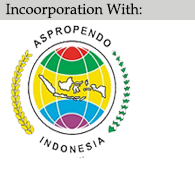Kontribusi Matematika Ekonomi dalam Pembelajaran Teori Ekonomi Mikro
Abstract
This research was conducted to determine the contribution of Economic Mathematics in learning Microeconomic Theory in the Economics Education Study Program of Jambi University. The research was conducted using the exposed pacto method. Data obtained from student learning outcomes and analyzed using Path Analysis techniques. The results of the analysis show that the competence of Economic Mathematics has a very significant contribution in learning Micro Economic Theory and is a mediator of the relationship between learning Introduction to Economics and learning Micro Economics Theory. Studying Microeconomic Theory will be more effective if students understand the basic concepts of economics and are supported by the ability to analyze Mathematical Economics. Thus, the course of Introduction to Economics and Economic Metrics must be a prerequisite for learning Micro Emonomics Theory.
DOI: https://dx.doi.org/10.17977/UM014v14i22021p106
Keywords
Full Text:
PDFReferences
Akintunde, A. 2012. Path Analysis Step by Step Using Excel. Journal of Technical Science and Technologies, 1(1):9-15
Hakam, M., Sudarno, dan Hoyyi, A. 2015. Analisis Jalur Terhadap Faktor-Faktor Yang Mempengaruhi Indeks Prestasi Kumulatif (IPK) Mahasiswa Statistika UNDIP. Jurnal Gaussian, 4(1), 61-70
Intisari. 2017. Persepsi Siswa Terhadap Mata Pelajaran Matematika. Wahana Karya Ilmiah Pendidikan, 1(1), 62-71.
Kohar. F., and Kuswanto. 2019. Development of Economic Mathematics Learning Materials Based on Problem Based Learning. Advances in Social Science, Education and Humanities Research, 295. 112-114.
Kuswanto and Refnida. 2020. Application Of Contextual Learning To Improve Learning Achievements In Microeconomic Theory Of Economics Education Students. International Journal Of Scientific & Technology Research, 9(1). 405-408.
Kuswanto. 2020. Development of Micro Economic Theory Teaching Materials with ADDIE Model Approaches. International Journal Of Scientific & Technology Research, 9(6). 383-387.
Mazana, M.Y., Montero, C.S., and Casmir, R.O. 2019. Investigating Students’ Attitude towards Learning Mathematics. International Electronic Journal Of Mathematics Education, 14(1), 207-231
Nuraini, I. 2016. Pengantar Ekonomi Mikro. Malang: UMM Press
Roflin, E. 2009. Penggunaan Metode Trimming pada Analisis Jalur dalam Menentukan Model Kausal Dana Alokasi Umum Kabupaten/Kota di Provinsi Sumatera Selatan. Jurnal Penelitian Sains, Edisi Khusus A(9), 1-9
Rogan, J. and Aldous, C. 2005. Relationships between the constructs of a theory of Curriculum implementation. Journal Of Research In Science Teaching, 42(3), 1–25. DOI 10.1002/tea.20054.
Salvatore, D. 2010. Microeconomic Theory. Jakarta: Erlangga
Sayaripah. (2016). Pengaruh Persepsi Pembelajaran Matematika Terhadap Motivasi Belajar Siswa dalam Bidang Matematika di Sekolah SMA N 1 Curup Timur T.P 2015/2016. Jurnal EduTech, 2(2), 117-131.
Setapa, M., Mustapha1, W.A.H.W., Kanafiah, S.F.F.H.M and Zaman, L.K. 2016. A Study of Students’ Perception toward Mathematic. Journal of Applied Environmental and Biological Sciences, 6(7S), 28-33
Sukirno, S. 2005. MikroEkonomi Teori Pengantar (Edisi ketiga). Jakarta: RajaGrafindo Persada
Wasike, A., Michael, N. and Joseph, K.K. 2013. The Impact of Perception on Performance in Mathematics of Female Students in Secondary Schools in Teso District, Kenya. Journal of Education and Practice, 4(20), 104-111.
Refbacks
- There are currently no refbacks.

Jurnal Penddidikan Ekonomi is licensed under a Creative Commons Attribution-NonCommercial-ShareAlike 4.0 International License





